#Triassic reptile fossil
Explore tagged Tumblr posts
Photo

RARE Fossil Reptile Bones and Coprolite – Aust Cliff UK – Upper Triassic Westbury Formation
RARE Fossil Reptile Bones and Coprolite – Westbury Formation, Aust Cliff, Bristol, UK – Upper Triassic
This is a carefully selected and authentic fossil slab containing both fossilised reptile bones and coprolite (fossilised faeces), recovered from the famous fish, reptile, and coprolite bed at Aust Cliff, Bristol. This site is one of the most scientifically significant Upper Triassic fossil localities in the UK.
Formation and Age:
Location: Aust Cliff, Bristol, UK
Geological Unit: Westbury Formation, Penarth Group
Stratigraphy: Upper Triassic (~208–201 million years ago)
Depositional Environment: Shallow marine to lagoonal – ideal for fossil preservation
Fossil Content and Scientific Context:
The coprolite is likely from Ceratodus, an extinct genus of lungfish, while the reptile bones may belong to small Triassic marine or semi-aquatic reptiles, such as early archosaurs. Fossils from this bed often preserve dietary and environmental data, making them important for scientific and educational purposes.
This block offers a rare opportunity to own multiple fossil types in one piece, showcasing the diverse ecosystem that existed in the Late Triassic coastal regions of Britain.
Features and Morphology:
Reptile bones typically show dark mineralisation with fine surface detail
Coprolite may exhibit spiral or segmented morphology consistent with lungfish
Contrasting matrix and fossil material provide a striking visual display
Authenticity and Preparation:
Discovered by our own field team (Alister and Alison) on 07 April 2025
Cleaned, prepped and treated by Alison to ensure stability and clarity
All fossils are 100% genuine and come with a Certificate of Authenticity
Scale cube = 1cm. Please refer to photos for full sizing
The specimen shown in the photograph is the exact item you will receive
Why Buy From Us:
We specialise in high-quality, scientifically interesting fossil specimens that are responsibly sourced and professionally prepared. Perfect for collectors, educators, or anyone looking to own a genuine piece of natural history.
#Fossil Reptile Bone#Coprolite#Aust Cliff Fossil#Westbury Formation#Upper Triassic Fossil#Penarth Group#UK Fossil#Genuine Fossil with Certificate#Bristol Fossils#Reptile Coprolite#Triassic Reptile Fossil#Fish Reptile Coprolite Bed#Authentic Prehistoric Fossil#Dinosaur Era Fossil
0 notes
Text

Paleovember 2023, Drepanosaurus!
Once again, the Triassic was a WEIRD time in evolutionary history, when life was throwing as much as it could at the wall and seeing what stuck before the dinosaurs became a major thing. One of these early experiments was Drepanosaurus, a roughly 20 inch long reptile from Italy, New Jersey and New Mexico about 230 mya. It bore a huge claw on ridiculously muscular forelimbs, adaptations which it used to rip into trees and dig out insects, much like the modern pygmy anteater.
#Drepanosaurus#triassic#reptile#fossil#illustration#animal#paleontology#paleoart#art#artwork#drawing#procreate#artist on tumblr
19 notes
·
View notes
Text




Top left is a reptile bone. Top right is an amphibian vertebrae. The strange piece is a limb bone but unable to tell from what. 220 mya. Late Triassic
3 notes
·
View notes
Text

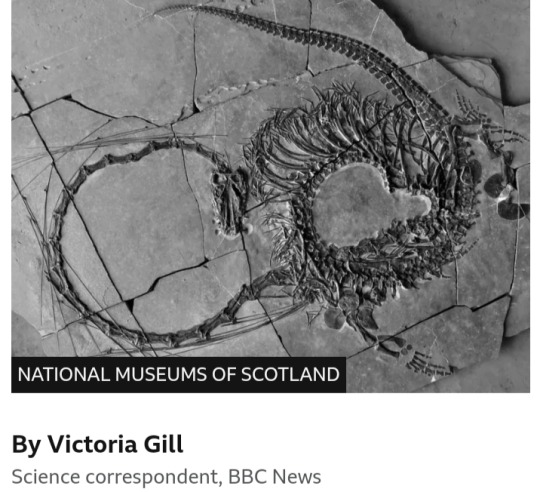
23 February 2024
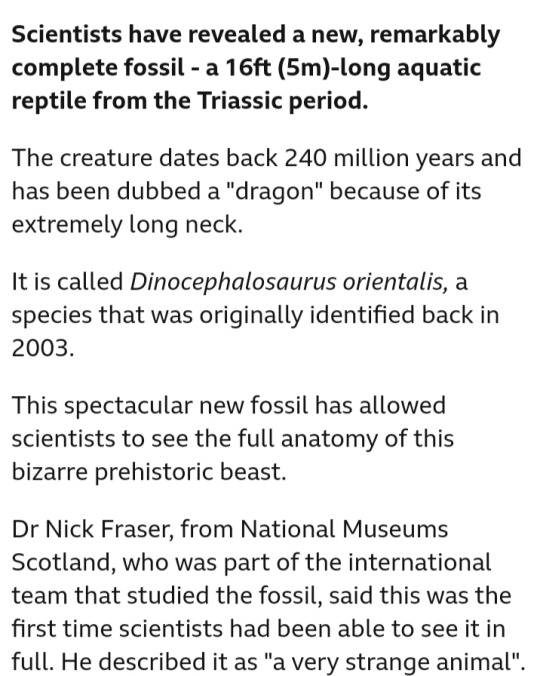
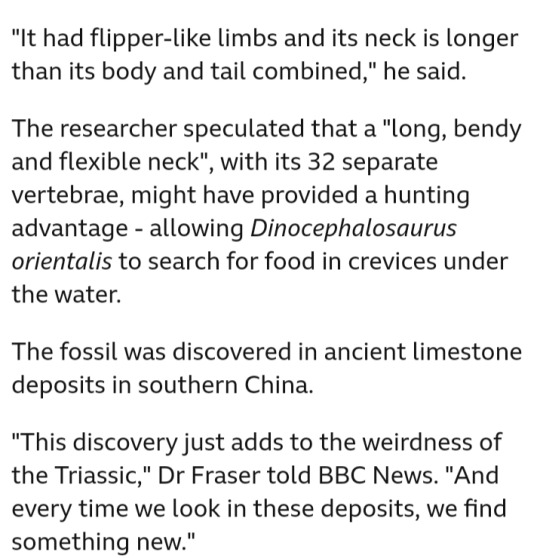
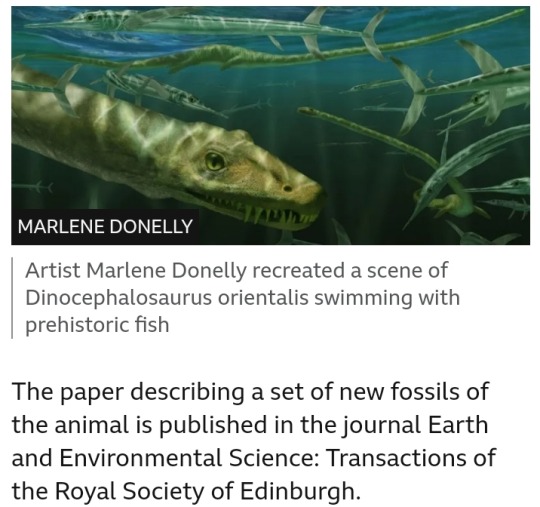

—
The Triassic period was the first period of the Mesozoic era and occurred between 251.9 million and 201.3 million years ago.
It followed the great mass extinction at the end of the Permian period and was a time when life outside of the oceans began to diversify.
#fossil#aquatic reptile#Triassic period#China#Dinocephalosaurus orientalis#Guizhou Province#marine reptile#National Museums of Scotland#mythical dragon#Mesozoic era
8 notes
·
View notes
Text

It's time for Fossil Friday! Meet Cryptocleidus oxoniensis, a short-necked plesiosaur. Plesiosaurs were large marine reptiles that lived from the late Triassic to the end of the Cretaceous. The plesiosaurs had extensive modifications to the shoulder and pelvic girdles: these elements form large, flat sheets of bone, presumably for the attachment of swimming muscles. Cryptocleidus' trunk was very rigid and short, and the short tail could only function as a rudder, leaving the limbs as its main organ of propulsion.
See this prehistoric critter, and more, at the Museum! Plan your visit.
Photo: © AMNH
316 notes
·
View notes
Text

Species of Ichthyosaur Is Largest Known Marine Reptile at 80 Feet Long
A father and daughter duo found the jawbone of the species and the research team named the new marine reptile species Latin for 'giant fish lizard of the Severn.'
A father and daughter, searching for fossils on an English beach, found more than they expected: the jawbone of what may be the largest known marine reptile. Scientists estimate that the giant ichthyosaur, from which the jawbone came, measured 80 feet long and lived during the late Triassic period. A report in the journal PLOS details the find. When Justin Reynolds and Ruby Reynolds (then 11) were combing the beach at Somerset in 2020 and came upon a giant bone chunk, they knew they were on to something. “When Ruby and I found the first two pieces we were very excited as we realized that this was something important and unusual,” said Reynolds in a release. So they contacted Dean Lomax, a University of Manchester paleontologist...
Read more: https://www.discovermagazine.com/the-sciences/species-of-ichthyosaur-is-largest-known-marine-reptile-at-80-feet-long
204 notes
·
View notes
Text
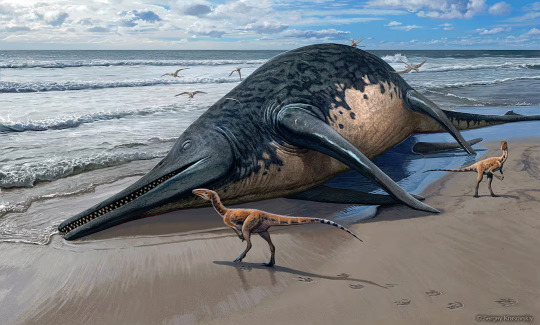
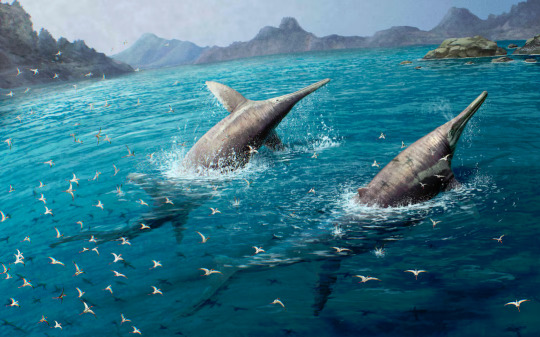
Gigantic marine reptile's fossils found by British girl and father April 17 (Reuters) - A fossil jawbone found by a British girl and her father on a beach in Somerset, England belongs to a gigantic marine reptile dating to 202 million years ago that appears to have been among the largest animals ever on Earth. Researchers said on Wednesday the bone, called a surangular, was from a type of ocean-going reptile called an ichthyosaur. Based on its dimensions compared to the same bone in closely related ichthyosaurs, the researchers estimated that the Triassic Period creature, which they named Ichthyotitan severnensis, was between 72 and 85 feet (22-26 meters) long. That would make it perhaps the largest-known marine reptile and would rival some of the largest baleen whales alive today. The blue whale, considered the largest animal ever on the planet, can reach about 100 feet (30 meters) long.
Don't mind me, just thinking about how fossils for marine life are rarer than for land-based life and there could have been all kinds of shit living in there that we haven't even discovered yet.
592 notes
·
View notes
Text

Postosuchus by Literalmente Miguel
Postosuchus, meaning "Crocodile from Post", is an extinct genus of rauisuchid reptiles... Postosuchus is a member of the clade Pseudosuchia, the lineage of archosaurs that includes modern crocodilians (the other main group of archosaurs is Avemetatarsalia, the lineage that includes all archosaurs more closely related to birds than to crocodilians). Its name refers to Post Quarry, a place in Texas where many fossils of the type species, P. kirkpatricki, were found. It was one of the apex predators of its area during the Triassic, larger than the small dinosaur predators of its time. It was a hunter which probably preyed on large bulky herbivores... (Wikipedia)
#archosaur#prehistoric#paleontology#reptile#rausuchian#postosuchus#animals#nature#paleoart#paleoillustration#art
126 notes
·
View notes
Text

Rob Little
Petrified Forest National Park is an American national park located in Navajo and Apache counties in northeastern Arizona. Named for its large deposits of petrified wood, the park covers about 346 square miles (900 km2), and includes semi-desert shrub-steppe as well as highly eroded and colorful badlands. The park's headquarters is located about 26 miles (42 km) east of Holbrook along Interstate 40 (I-40), which parallels the South Transcon Line. The site, the northern portion of which extends into the Painted Desert, was declared a national monument in 1906 and a national park in 1962. The park has an average elevation of about 5,400 feet (1,600 m), and has a dry, windy climate with temperatures ranging from In the summer it is about 100°F (38°C) to winter lows well below freezing. The park has more than 400 species of plants, dominated by grasses such as punchweed, blue grama, and sacaton. Animals include larger animals such as pronghorn, coyotes, and lynx; many small animals, such as deer, mice, snakes, lizards and seven species of amphibians; And more than 200 species of birds, some of which are permanent residents and many of which are migratory. About one-third of the park is designated wilderness—50,260 acres (79 sq mi; 203 km2)—
The Petrified Forest is famous for its fossils, especially deciduous trees that lived in the Late Triassic, about 225 million years ago. The deposits containing the fossil trunks are part of the colorful and widespread Chinle Formation, from which the Painted Desert gets its name. Beginning about 60 million years ago, the Colorado Plateau, of which the park is a part, was pushed upward by tectonic forces and subjected to further erosion. All of the park's rock layers above the Chinle River, except for younger geological strata in parts of the park, have been removed by wind and water. In addition to fossilized tree trunks, fossils found in the park included Late Triassic ferns, cycads, ginkgos, and many other plants as well as animals including giant reptiles called phytosaurs, large amphibians, and early dinosaurs. Paleontologists have discovered and studied the park's fossils since the early 1900s.
350 notes
·
View notes
Text
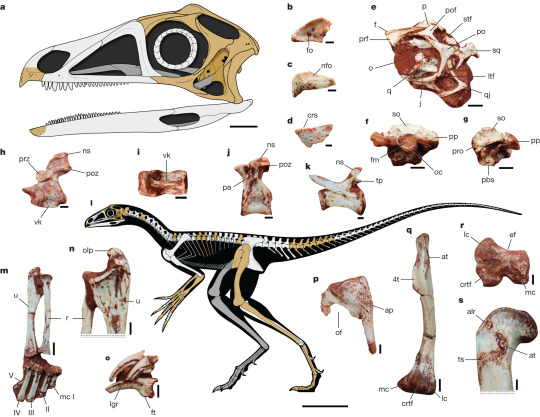
Still no new croc stuff from me (but I got something in the works), so instead more general paleonews. Today, a new pterosaur ancestor and it looks WEIRD.
This is Venetoraptor gassenae (Gassen's Plunderer from Vale Veneto) is a new lagerpetid literally just published a couple of minutes ago. According to its description (and as seen in the image) it had a toothless premaxilla that was hooked like the beak of a raptorial bird. It may have been covered in keratin, which is interesting as the skulls of early pterosaurs appear to have been smooth. The hands are obviously enormous and the size differences between the fingers are well in line with what pterosaurs would later have (i.e. the fourth finger is the longest, the fifth is reduced in Venetoraptor and absent in pterosaurs), but the legs are still much longer. The claws are described as sharp and scythe-like and again, its interesting that the fourth is the longest, as in other lagerpetids its usually the third that exceeds all others in length. Interesting connection between Veneto and pterosaurs for sure.

In terms of relationships it was found to be nested deep in lagerpetids, which, expectedly are recovered as the sister group to pterosaurs.
It seems to represent a whole new ecomorph not previously known from this group and interestingly coexisted not just with the related Ixalerpeton, but also with some early dinosaurs like Buriolestes. The beak is also interesting. Similar beaks have evolved multiple times in Triassic archosaurs and the hooked tip in particular is common even in modern birds, tho the authors argue that we know too little to say what precisely it was used for. Could be used for ripping flesh (like in falcons) or for eating fruit (like in parrots, fun fact, falcons and parrots are close relatives). As for the hand, the authors suggest that a big driver for ornithodirans playing around with them as the fact that they were not forced to be quadrupedal, so they could be more experimental, leading to hands fit for grasping, climbing and eventually flight.
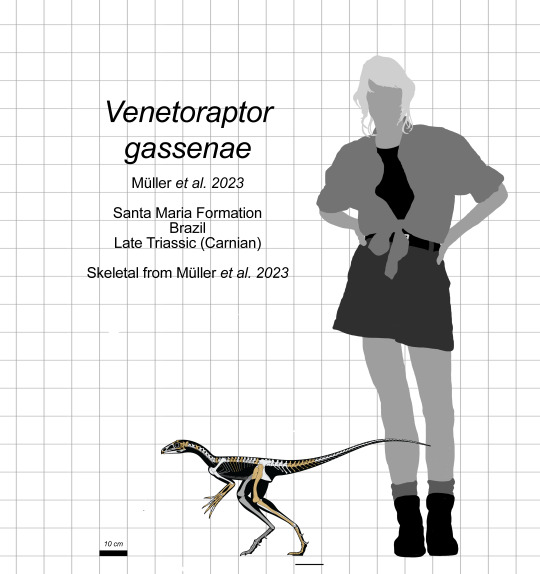
Also for all those aware of the issues surrounding Brazilian fossils, rest assured, the fossil is being kept at the Centro de Apoio à Pesquisa Paleontológica da Quarta Colônia da Universidade Federal de Santa Maria, so it is in Brazil. The authors are primarily Brazilian (including the lead author Rodrigo Müller) and Argentinian, with two from the USA. Linke: New reptile shows dinosaurs and pterosaurs evolved among diverse precursors | Nature
#pterosauria#pterosaur#evolution#triassic#palaeoblr#paleontology#prehistory#venetoraptor#size comparisson#lagerpetidae
783 notes
·
View notes
Text
I'm really behind on Animorphs, but I'm catching up. Just got through 12 this weekend, and since the last time I read, I've gotten really into paleontology, so the pedant in me had to come out lmao. Crocodiles are not that old. They're certainly not older than birds. Crocodilians don't appear until the Cretaceous actually (birds start appearing in the Jurassic), and it's kind of a misnomer to call them living fossils and imagine them as unchanged by time, not a dynamic evolving animal.
The clade that crocodilians nest within, pseudosuchia, has a diverse history with a lot of different kinds of animals filled various niches, and some of them were likely even endothermic. Crocodilians are a relatively recent member of the clade, but before that, diverse pseudosuchians were a dominant lifeform of the Triassic, when dinosaurs were just starting to evolve. But those animals weren't crocodiles. In fact, many of them look more like the 80s/90s portrayals of dinosaurs than modern crocodiles. While the book emphasizes their cold, uncaring nature, crocodiles have an interesting position amongst reptiles. Being archosaurs (the group of reptiles that birds also belong to), they are more attentive parents than non-archosaur reptiles. That by no means makes them cuddly, but it's still interesting imo. They also have a respiratory system similar to birds and are their closest living relative. It's kind of funny to think a crocodile and a red tailed hawk are closely related and have some shared features. Just fun pseudosuchian facts lol.
25 notes
·
View notes
Photo

RARE Keichousaurus hui Fossil, Triassic Reptile, Guanling Formation, China | Genuine Specimen + COA
RARE Keichousaurus hui Fossil from the Guanling Formation, Triassic Period – Guizhou Province, China
This extraordinary fossil features the complete or near-complete remains of Keichousaurus hui, a marine reptile that lived approximately 240 million years ago during the Middle Triassic epoch. Unearthed from the world-famous Guanling Formation in Guizhou Province, China, this specimen is a rare and scientifically significant piece, perfect for fossil collectors, natural history enthusiasts, and educational displays.
Fossil Type & Species:
Type: Vertebrate Fossil (Reptile)
Species: Keichousaurus hui
Order: Sauropterygia
Superfamily: Pachypleurosauroidea
Family: Keichousauridae
Identified by: Originally described by Chinese palaeontologist Yang Zhongjian (Chung-Chien Young) in 1958
Geological Details:
Formation: Guanling Formation
Period: Triassic (Anisian Stage, Middle Triassic – approx. 247 to 237 million years ago)
Zone/Biozone: Not formally assigned to a specific biozone but typical of the fossil-rich marine strata of the Anisian
Depositional Environment: Shallow marine lagoon or shelf setting with fine-grained sedimentation, ideal for exceptional fossil preservation
Morphology & Features:
Keichousaurus hui is a small marine reptile resembling a lizard in body shape. It is characterized by:
A long, slender neck with approximately 25 cervical vertebrae
Four well-developed flipper-like limbs adapted for swimming
A long tail used for propulsion
Clearly defined ribs and vertebral column
In some specimens, you can observe fine details such as skull structure and even gastralia (belly ribs)
This particular specimen exhibits excellent articulation and preservation, with visible limb bones, vertebrae, and overall body outline.
Specimen Details:
Origin: Guanling Formation, Guizhou Province, China
Species: Keichousaurus hui
Age: Middle Triassic (Anisian Stage)
Matrix: Fine-grained limestone slab
Fossil Type: Full or near-complete articulated skeleton
Size Reference: Scale rule square = 1cm (please see photo for full sizing)
Note: You will receive the exact fossil specimen shown in the photographs
Authenticity & Quality:
We carefully select all our fossils based on scientific relevance, aesthetic quality, and authenticity. This specimen is 100% genuine and comes with a Certificate of Authenticity. The photo shows the actual fossil you will receive, not a stock image.
Why Choose This Fossil?
This Keichousaurus hui fossil is a standout example of Triassic marine reptile life, making it an ideal piece for:
Palaeontological study
Educational collections
Museum-quality display
Gifts for fossil enthusiasts or students
Shipping & Packaging:
We use eco-conscious, secure packaging to ensure your fossil arrives safely and in excellent condition. Fast and careful dispatch provided.
Add a genuine piece of prehistoric marine life to your collection with this stunning Keichousaurus hui fossil.
All of our Fossils are 100% Genuine Specimens & come with a Certificate of Authenticity.
#Keichousaurus hui fossil#Triassic reptile fossil#Guanling Formation#Guizhou Province fossil#Chinese dinosaur fossil#rare reptile fossil#authentic Keichousaurus#Triassic marine reptile#lizard-like fossil#genuine fossil specimen#fossil with COA#prehistoric reptile fossil#collector fossil#palaeontology specimen#fossil reptile plate
0 notes
Text
Archovember 2024 Day 27 - Tanystropheus longobardicus
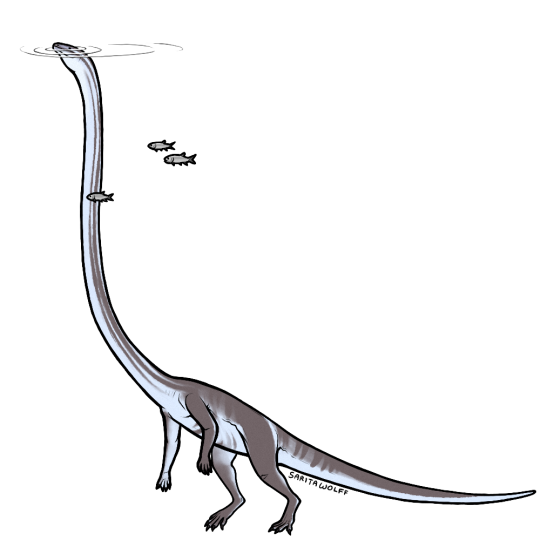
Our last non-archosaur archosauromorph of this Archovember (say that 5 times fast) is Tanystropheus longobardicus. This archosauromorph lived in the Middle Triassic of what is today the border of Italy and Switzerland. It’s most recognizable feature is its long neck, made up of 13 lengthened vertebrae, that stretched out longer than its body and tail combined! What it was doing with this long neck is the subject of debate. The neck was not very flexible, made of long, stiff vertebrae, though it was lightweight and stabilized by tendons. Tanystropheus was likely a fish-eater, with T. longobardicus in particular being equipped with three-cusped teeth suited for holding onto slippery prey, and fish scales and cephalopod hooklets have been found in the stomach region of some specimens. Its body did not seem to have many adaptations for swimming, though its muscular hindlimbs and tail may have allowed for short bursts of active swimming in shallow water. It’s hypothesized that Tanystropheus was a semi-aquatic ambush predator, either using its long neck to reach across the water and snap up fish like a heron, or waiting in the water like a turtle, its body unseen and long neck appearing like an innocent branch.
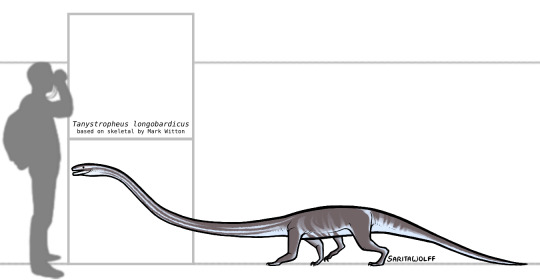
Tanystropheus longobardicus was the smallest of the known species of Tanystropheus. It lived alongside the larger, bulkier T. hydroides, while even larger Tanystropheus specimens have been found in Germany and Poland. Fossils have also been found in Canada and China, meaning this genus may have had a worldwide distribution. But T. longobardicus in particular lived in the Besano Formation. It was set apart from the larger T. hydroides by its small size, narrow triangular head, and tricuspid teeth in the back of its skull. Meanwhile, the larger T. hydroides had a broader skull and long interlocking fangs. The two species likely did not compete, as T. hydroides would have preferred much larger fish than T. longobardicus. But these were not the only tanystropheids in the Bessano Formation. They would have also lived alongside the smaller, shorter-necked, terrestrial tanystropheid Macrocnemus bassanii. On land, Tanystropheus longobardicus would have had to worry about the early rauisuchian Ticinosuchus. In the sea, Tanystropheus would have had to look out for the nothosaur Nothosaurus, large thalattosaurs like Askeptosaurus, large predatory fish like Birgeria, and even large icthyosaurs like Besanosaurus and Cymbospondylus. It may have also come across smaller icthyosaurs like Mixosaurus, Phalarodon, and Wimanius, as well as placodonts like Cyamodus and Paraplacodus, pachypleurosaurs like Serpianosaurus and Odoiporosaurus, and other reptiles like Silvestrosaurus, Helveticosaurus, and Eusaurosphargis. It could have eaten small fish like Aetheodontus, Cephaloxenus, and Luganoia, and even small coelocanths like Ticinepomis.

This art may be used for educational purposes, with credit, but please contact me first for permission before using my art. I would like to know where and how it is being used. If you don’t have something to add that was not already addressed in this caption, please do not repost this art. Thank you!
#Tanystropheus longobardicus#Tanystropheus#tanystropheid#archosauromorphs#reptiles#Archovember#Archovember2024#Dinovember#Dinovember2024#SaritaDrawsPalaeo#Middle Triassic#Italy#Switzerland#Bessano Formation
56 notes
·
View notes
Text
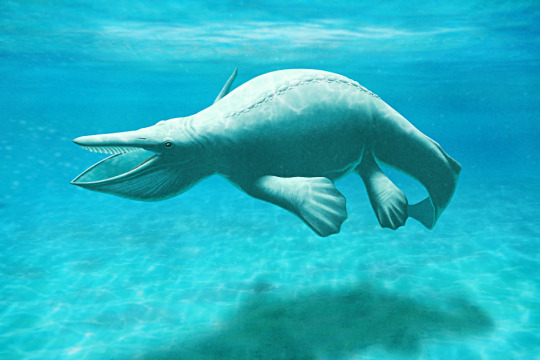
Hupehsuchians were small marine reptiles closely related to ichthyosaurs, known only from the Early Triassic of southwestern China about 249-247 million years ago. They had toothless snouts, streamlined bodies, paddle-like limbs, and long flattened tails, along with a unique pattern of armor along their backs made up of overlapping layers of bony osteoderms.
Hupehsuchus nanchangensis was a mid-sized member of the group, about 1m long (3'3"). Newly-discovered fossils of its skull show that its long flattened snout had a distinctive gap between the bones (similar to the platypus-like snout seen in its relative Eretmorhipis) with an overall shape surprisingly convergent with that of modern baleen whales – suggesting that this hupehsuchian may have been a similar sort of filter-feeder.
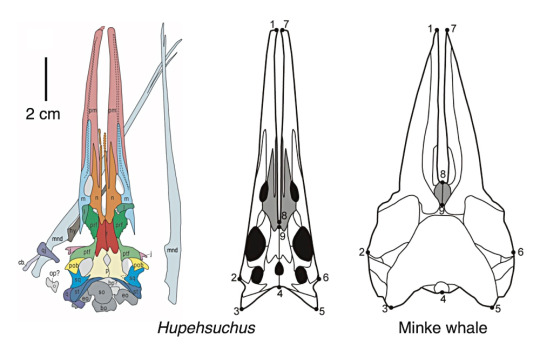
Hupehsuchus skull compared to a modern minke whale [From fig 2 & fig 3 of Fang et al (2023). First filter feeding in the Early Triassic: cranial morphological convergence between Hupehsuchus and baleen whales. BMC Ecol Evo 23, 36. https://doi.org/10.1186/s12862-023-02143-9]
Grooves in the bones along the outer edges of its upper jaws may be evidence of filtering structures similar to baleen, although with no soft-tissue preservation we don't know exactly what this would have looked like. Its slender flexible lower jaws probably also supported a large expandable throat pouch, allowing it to filter plankton out of larger volumes of water.
———
NixIllustration.com | Tumblr | Patreon
#science illustration#paleontology#paleoart#palaeoblr#hupehsuchus#hupehsuchia#ichthyosauromorpha#reptile#marine reptile#art#triassic weirdos
603 notes
·
View notes
Text

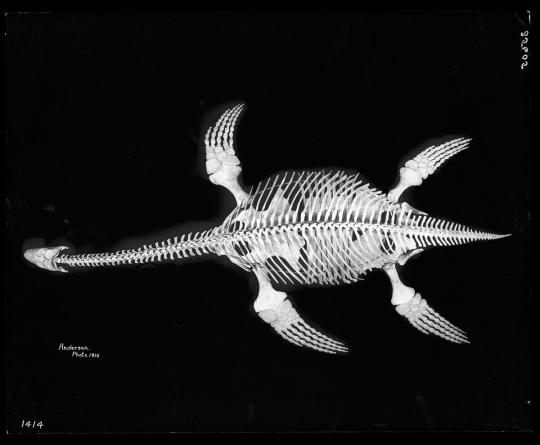
It's time for Fossil Friday! Meet Cryptocleidus oxoniensis, a short-necked plesiosaur. Plesiosaurs were large marine reptiles that lived from the late Triassic to the end of the Cretaceous. The plesiosaurs had extensive modifications to the shoulder and pelvic girdles: these elements form large, flat sheets of bone, presumably for the attachment of swimming muscles. Cryptocleidus' trunk was very rigid and short, and the short tail could only function as a rudder, leaving the limbs as its main organ of propulsion.
Photos: © AMNH
Image 1: Cryptocleidus on display in the Museum.
Image 2: Photographic negative of the fossilized remains of Cryptocleidus, circa 1910.
#science#amnh#museum#fossil#nature#natural history#animals#paleontology#plesiosaur#cretaceous#triassic#cool animals#ancient animals#fossil friday
449 notes
·
View notes
Text
ㅤㅤㅤDINOSAUR — THEMED ; ID PACK
lowkey dont wanna do a graphic for this </3 no energy sorry
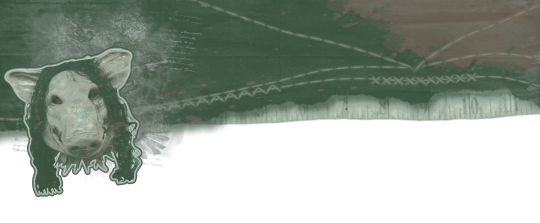
NAMES ; Rex(ie), Aardon, Nyx, Hyla, Amygda, Draco, Dyno or Deino, Dino, Khaan, Toro, Tyr, Tyra, Bambi, Chimera, Raptor, Chomp, Spike, Rocky or Rockie, Bron, Titan, Cory, Dax, Othnelia, Othniel, Sharptooth, Sinclair, Jagger, Hammer, Stegz, Brokenhorn, Scales, Blue, Cera, Petra or Petrie, Pterri, Kron, Onyx, Anzu, Velo, Delta, Echo, Obsidian, Pebbles, Trix(ie), Fern, Ember, Tooth(less), Zephyr, Trex, Max, Stella
PRONOUNS ; dino/dinos, dino/dinosaur, bone/bones, foss/fossils, pre/prehistoric, spine/spines, teeth/teeths, tooth/tooths, teeth/tooths, paleo/paleos, stego/stegos, roar/roars, extinct/extincts, tri/triassic or triassic/triassics, scale/scales, rep/reptile or rep/repts, claw/claws, ancient/ancients, speci/specimen, saur/saurus
TITLES ; The Intimidating [x], The Carnivore, The Herbivore, The Omnivore, The Prehistoric [x], The Top of the Food Chain, The Flying Dino(saur), The Dino(saur) With Large Horns, The One Who Defends [x], The Spikey Dino(saur) / [x], The Hunting [x], The Fastest Dino(saur) in the Chain
LABELS ; Dinoboy + Dinogirl, Dinoboygirl, Dinoflux, Dinoskeletic, Dinothing, Dinodeity, Velocirdeity, Moondinogender, Collectdinogender, Skullshroomdinogender, Deinonychusgender, Sauriextranic + Orninthiextranic, Spinosaurugender, Triceragender, Tyrannosaurugender, Dinoplushgender, Brachiocream, Various Dinogender flags, Cottoncandydino, Pastdinogender, Dinotoyic, Ceratosaurugender, Demidinogender
also see: dino-devilz's dino-identities post. @/mogaisaur.

ㅤNOTESㅤ— Sorry for a lack of titles... I didn't know what to put T_T
Anything marked with [x] may be replaced with a noun of choice, or a pronoun.

#🧱 [ THROW-UPS ] ⋮ REQUESTS#🏙️ [ CREWS ] ⋮ ID PACKS#mogai#mogai blog#title help#title suggestions#title list#pronoun help#pronoun suggestions#pronoun list#name help#name suggestions#name list#id pack#npts#dino npts#dinogender
10 notes
·
View notes